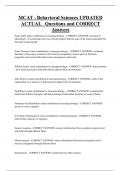MCAT - Behavioral Sciences UPDATED
ACTUAL Questions and CORRECT
Answers
Franz Gall's main contribution to neuropsychology - CORRECT ANSWER- doctrine of
phrenology - if a particular trait was well-developed, then the part of the brain responsible for
that trait would expand
Pierre Flourens' main contribution to neuropsychology - CORRECT ANSWER- examined
functions of the major sections of the brain by extirpation (various parts of the brain
surgically removed and the behavioral consequences observed)
William James' main contribution to neuropsychology - CORRECT ANSWER- functionalism
- how mental processes help individuals adapt to their environments
John Dewey's main contribution to neuropsychology - CORRECT ANSWER- study of the
organization as a whole as it functioned to adapt to the environment
Paul Broca's main contribution to neuropsychology - CORRECT ANSWER- examined the
behavioral deficits of people with brain damage to determine functions of areas of brain
Hermann von Helmholtz's main contribution to neuropsychology - CORRECT ANSWER-
speed of a nerve impulse
Sir Charles Sherrington's main contribution to neuropsychology - CORRECT ANSWER-
inferred the existence of synapses
Sensory neurons - CORRECT ANSWER- sensory information from receptors to spinal cord
and brain through afferent fibers
Motor neurons - CORRECT ANSWER- motor information from brain and spinal cord to
muscles and glands through efferent fibers
Interneurons - CORRECT ANSWER- found between other neurons
,Central nervous sytem (CNS) components - CORRECT ANSWER- brain and spinal cord
Peripheral nervous system (PNS) components - CORRECT ANSWER- nerve tissue and
fibers outside the brain and spinal cord
Somatic nervous system - CORRECT ANSWER- sensory and motor neurons distributed
throughout the skin, joints, and muscles
Functions of the autonomic nervous system - CORRECT ANSWER- regulates automatic
functions such as heartbeat, respiration, digestion, and temperature control
Function of the parasympathetic nervous system - CORRECT ANSWER- rest and digest
Function of the sympathetic nervous system - CORRECT ANSWER- fight or flight
Functions of the meninges and its three components - CORRECT ANSWER- functions:
protect brain, keep anchored, resorb cerebrospinal fluid
components: dura matter, arachnoid matter, pia matter
Parts of the brain that make up the brain stem - CORRECT ANSWER- midbrain
(mesencephalon) and rhombencephalon (hindbrain)
Last part of the brain to develop - CORRECT ANSWER- forebrain (prosencephalon)
Cerebral cortex - CORRECT ANSWER- outer covering of the cerebral hemispheres
Main function of the hindbrain - CORRECT ANSWER- manage vital functions necessary for
survival
Rhombencephalon divisions and their functions - CORRECT ANSWER- myelencephalon
(medulla oblongata) and metencephalon (pons and cerebellum)
,Functions of the medulla oblongata - CORRECT ANSWER- regulate breathing, heart rate,
and blood pressure
Function of the pons - CORRECT ANSWER- contains sensory and motor information
between cortex and medulla
Functions of the cerebellum - CORRECT ANSWER- help maintain posture and balance and
coordinate body movements
Divisions of midbrain and their functions - CORRECT ANSWER- superior colliculus
(visual) and inferior colliculus (auditory)
Main functions of the forebrain - CORRECT ANSWER- complex perceptual, cognitive, and
behavioral processes, emotion, and memory
Divisions of the prosencephalon - CORRECT ANSWER- telencephalon (cerebral cortex,
basal ganglia, and limbic system) and diencephalon (thalamus, hypothalamus, posterior
pituitary gland, and pineal gland)
Three common methods of brain mapping - CORRECT ANSWER- cortical maps (patient
assistance), electroencephalogram (electrical activity through electrodes), and regional
cerebral blood flow (broad patterns of neural activity based on increased blood flow to
different parts of the brain)
Main function of the thalamus - CORRECT ANSWER- sorts and transmits incoming sensory
information to the appropriate areas of the cerebral cortex
Main functions of the hypothalamus - CORRECT ANSWER- homeostatic functions, key
player in emotional experiences during high arousal states, helps control some endocrine
functions as well as the ANS
Function of the lateral hypothalamus (LH) - CORRECT ANSWER- hunger center, detects
when the body needs more food or fluids
Function of the ventromedial hypothalamus (VMH) - CORRECT ANSWER- satiety center,
provides signals to stop eating
, Function of the anterior hypothalamus - CORRECT ANSWER- controls sexual behavior
Functions of the posterior pituitary gland - CORRECT ANSWER- projection of
hypothalamus, release of ADH and oxytocin
Functions of pineal gland - CORRECT ANSWER- key player in several biological rhythms,
secretes melatonin
Functions of the basal ganglia - CORRECT ANSWER- coordinate muscle movement as they
receive information from the cortex and relay this information
Limbic system - CORRECT ANSWER- structures primarily associated with emotion and
memory
Function of the septal nuclei - CORRECT ANSWER- one of the primary pleasure centers of
the brain
Function of the amygdala - CORRECT ANSWER- important role in defensive and
aggressive behaviors, including fear and rage
Function of the hippocampus - CORRECT ANSWER- vital role in learning and memory
processes, consolidates information to form long-term memories, and can redistribute remote
memories to the cerebral cortex
Cerebral cortex and its components - CORRECT ANSWER- outer surface of the brain, 4
lobes (frontal, parietal, occipital, temporal)
Frontal lobe regions and their functions - CORRECT ANSWER- prefrontal cortex (executive
functions - perception, memory, emotion, impulse control, and long-term planning), primary
motor cortex (initiates voluntary motor movements), Broca's area (vitally important for
speech production)
Functions of the parietal lobe - CORRECT ANSWER- involved in somatosensory
information processing




